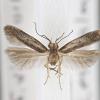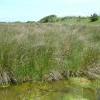35.068 Monochroa tetragonella (Stainton, 1885)
Status and Distribution
Very local, recorded historically from 18 widely scattered coastal saltmarsh sites in England and Wales. Since 2000 it has only been recorded at ten of these sites but is possibly under-recorded. It can be present in abundance at some of these sites and the moth has been known to wander a few kilometres inland following tidal inundation of their nearby coastal habitat.

Provisional map
Finding the Moth
Larva: plants with brown discolouration of the leaves or which appear to be dying should be checked for larva during April and May.
Adult: rests on the stems of saltmarsh plants and flies in the evening. Later comes to light.
Similar Species
Of a similar size to, and utilises the same habitat as Elachista scirpi which it may superficially resemble if worn. When reasonably fresh, the all greyish fuscous forewing with four short black streaky spots (two in the lower portion of the basal half and two in the upper portion of the outer half) and the more upturned whitish palps with a dark tip separate M. tetragonella from this species. E. scirpi is generally a paler moth and usually has an obvious white band or streak running from just above the tornal area to the apex of the forewing, not present in M. tetragonella.
Single brooded from late June to mid-July.
Earliest: 17th June 2010 (VC66)
Latest: 16th July 2013 (VC60)















